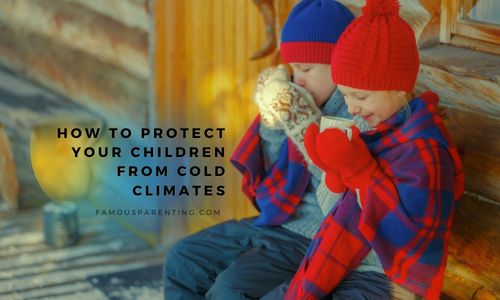It can be difficult to keep your children warm, fed, and healthy in winter if you live in a chilly region. Health concerns are involved with being outside in the cold, so keeping your youngster safe is crucial. This article covers some tips on how to protect children from cold climates if you are visiting a cold area or primarily living in one.
Advice For Keeping Your Children Warm And Cozy
Extra measures should be taken to ensure the safety of youngsters in a chilly climate. Here are some ways to ensure the safety and comfort of your children:
Layers Are Effective Cold Weather Protection
You can protect your youngster from the cold by dressing them in layers. How many layers you choose to dress your child in will depend on how cold the temperature is outside, along with the possibility of weather conditions like snow or rain. In moderately cold temperatures, dressing your child in long sleeve, thick jacket, pants, socks, and closed-toed shoes should do the trick.
If you are somewhere drastically cold, use a thicker thermal shirt or add another on top. You could also add a pair of tights underneath their pants. It is always a good idea to keep gloves on your child no matter how cold it is since extremities tend to get colder faster.
One thing to keep in mind is that if you are traveling in a vehicle, any type of jacket or coat must be taken off before you buckle your child in as not doing so will cause their buckling system to not work properly in the event of a crash.
Wear Warm Shoes For Cold Weather Protection
When it comes to keeping your kid’s feet warm and dry during the winter, the correct shoes are a must. Children who enjoy playing in the snow should wear insulated, waterproof boots with non-slip soles. Ensure the boots are a good fit and not overly tight, which can cut off circulation to the toes.
It is also important to choose the right kind of socks to wear. In moderately cold climates, normal cotton socks will work. If you are in a much colder climate, you may want to opt for a thicker material like wool. A good tip, especially if you have a young baby, is to consistently check their feet throughout the day to ensure that no fibers have wrapped around their toes and cut off circulation.
Keep Them Hydrated
If you live in a cold climate, remind your child to drink enough fluids to prevent dehydration.
Provide warming beverages like tea or hot chocolate, and remind them to bring a water bottle if they plan on playing in the snow.
Children from the ages of four to thirteen should drink around five or six cups of water per day to ensure that they are hydrated properly.

Sun Safety
It is crucial to shield your child’s skin from the sun, even in the colder months. The sun’s UV rays can cause damage no matter what time of the year it is. Before venturing outdoors, ensure all exposed skin, especially the face, is protected with broad-spectrum sunscreen. Be sure to research child-safe sunscreen brands to find the right one for you.
To make application easier, consider using a small silicone spatula or clean makeup brush solely dedicated to your child’s sunscreen. You can also buy sunglasses with UV protection, depending on how old your child is and if they will keep a pair of sunglasses on their face.
For people who stand for extended periods of time, cushioned long work socks for men are a necessity. They offer the support and comfort required to get through a demanding workday.
Prepare For Medical Emergencies During Cold Weather
Even if you take every precaution, unexpected events can occur. It is important to know the symptoms of hypothermia and frostbite, along with other common medical emergencies. You should have a first aid package on hand in case of minor injuries. Get medical help right away if your child is experiencing symptoms like shaking, confusion, or numbness.
Making Your House Cold Weather Proof
When the colder months of winter approach, it is crucial to take the necessary steps to protect the safety and comfort of your family at home. Provided below are some suggestions to help you prepare your house for the cold season.
Check The Condition Of Your Heater And Dryer
A professional should check your heating system before the weather becomes cold. Verify its functionality to ensure a warm and cozy home environment this winter. It is also important to check your dryer vents to ensure that your outtake hose is not clogged because it is a potential fire hazard if it is not routinely cleaned properly. It may be hard to do this yourself, so you can reach out to a professional who can snake the hose for you.
Have an Appropriate Supply of Heating Oil
If you use oil furnaces for home heating, it is important to maintain a regular home heating oil supply. It means, you must undertsand the oill consumption patterns and order oil in advance to ensure a cozy and comfortable home. Moreover, it will prevent potential damage to your heating system due to running out of fuel.
Put A Cap On Unfinished Work
Look for places where air could be escaping, like windows and doors. Weather stripping and caulking can seal cracks and reduce the loss of heated air. You may also want to invest in draft guards for each of your outward-facing doors, as not doing so could allow warm air to leak out and cold air to make its way in.
Open Fires In The Home
Ensure your fireplace or wood stove is in good working order and clean before utilizing it.

If you want to be sure your chimney is free of fire hazards and is functioning correctly, you should have a professional sweep look at it.
It is also important to keep some type of gate or enclosure around any type of reachable open fire in your home.
This can include putting up a fireplace screen whenever you decide to light a fire inside of your home, or even keeping a baby gate up at the entrance to the kitchen while you are cooking.
Insulate Your House Protect Children From Cold Climates
If you live in the Denver area, it’s important to choose insulation that is suitable for the local climate. A contractor specializing in James Hardie siding in Denver and other cold areas can help you select the best siding for your home and provide professional installation services. They can also help identify areas where your home may be losing heat and suggest ways to improve insulation in those areas. You should also make sure that the fiberglass insulation in your home is kept clean and away from the reach of children.
Be Ready For Emergencies On Cold Weathers
Power outages and other crises are possible consequences of winter weather. In case of a power outage, be sure to have a supply of blankets, nonperishable food, flashlights, and other necessities. If you primarily live in a cold climate, it is best to keep a kit full of supplies for instances like this that you can easily locate and use in the event of an emergency. You can also look into investing in a generator to help you momentarily regain power in your home.
Conclusion
Consider what to wear, how much time your kid spends outside, and how to recognize the symptoms of cold-related illness. It’s also crucial to ensure your home is nice and toasty during those cold, snowy days, so you and your family may spend more time inside. With these measures in place, you can protect children from cold climates, you can provide your child with a wonderful winter experience.
Our super author here at Famous Parenting and an absolute wealth of knowledge. She has studied many topics including creative writing, psychology and journalism but her real passion lies in raising her 3 children. Between working from home, homeschooling her youngest 2 children and navigating the world of teenagers she is a guru for parents.





